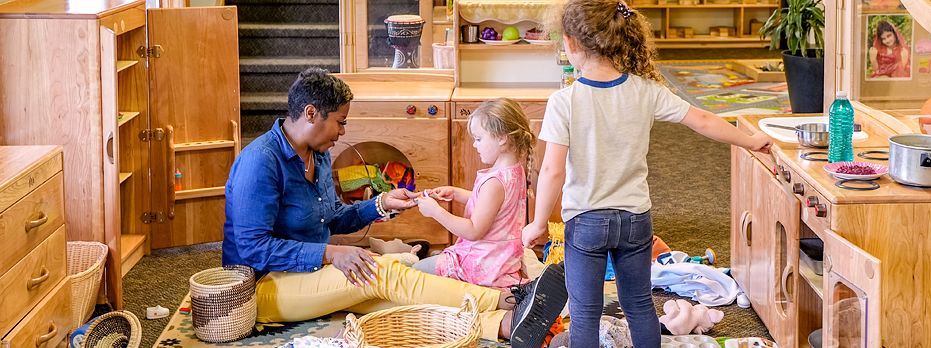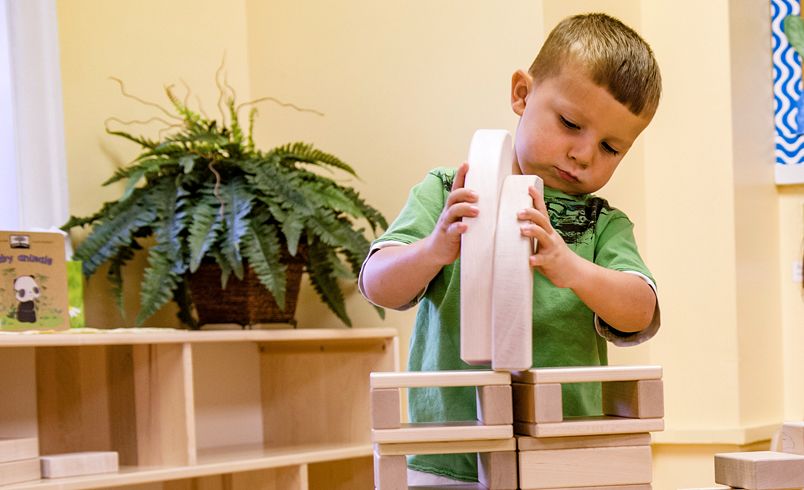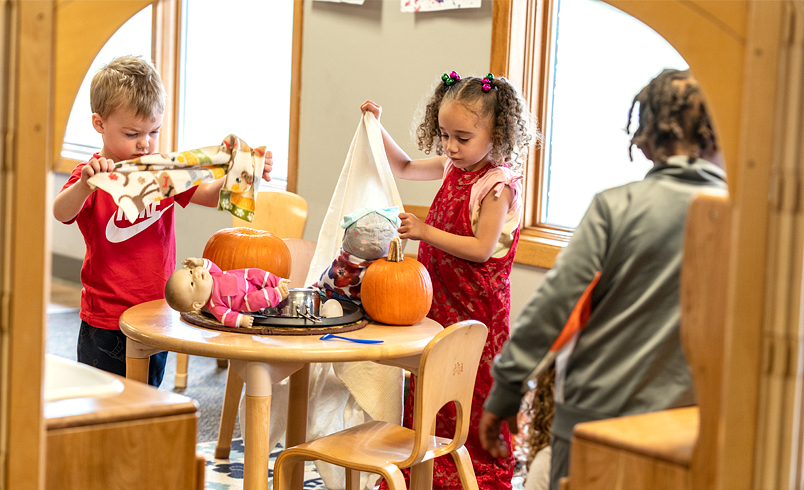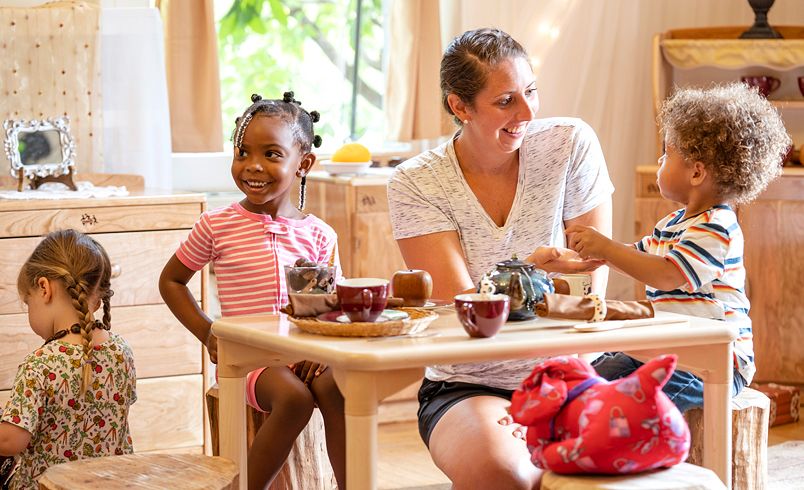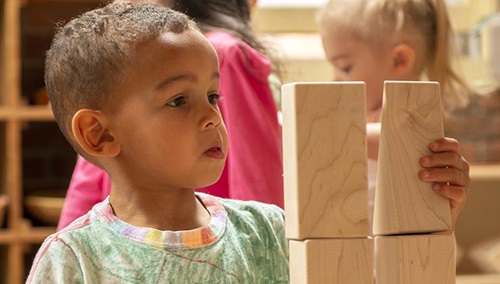Balancing a Successful Classroom Means Play
| January 2023For as long as teachers have been teachers there has been the debate: “What is the best method of education?” Influential early childhood educators such as Montessori, Froebel, Steiner, and Piaget, have left their indelible answers to this question in established pedagogies. More recently, beloved figureheads like Vivian Gussey Paley and Bev Bos have set the tone through their exuberant examples. Through it all there has been a steady tension between child-led experiences and teacher-directed instruction. Today, armed with this wealth of historic expertise, as well as more recent research, brain science, and new creative techniques, educators must discover the delicate balance for their particular classroom.
For instance, if we are introducing content such as shapes to 4-year-olds, we might start during large group instruction where we impart knowledge through a story with materials, a video, a discussion, or game all planned and executed by the teacher. Children may provide input, but the teacher decides the parameters. A step toward child-led experiences would be exemplified by leading children into learning centers where they are given instructions or ideas that would allow for them to manage the information they have been given combined with some level of exploration, but still working toward a desired outcome or answer. Dividing the table in two and putting out pattern blocks for children to sort would be one example.
Another step closer to a child-led activity would be children playing with blocks that include the targeted shapes. A teacher then might take a backseat by just observing and taking notes on children’s conversations.
Finding the Balance
No matter what approach you adopt for your classroom, there is always the question of why it is critical to prioritize play. Maria Montessori offers a response in her famous line, “Play is the work of the child.” Often, adults misread play as shallow, frivolous, or even unscholarly. As educators, it can be easy to forget the importance of play when navigating the course of our days with tight schedules, lesson objectives, and unexpected urgent tasks. Allowing children to play, however, is essential for their developmental growth and later achievement of academic standards.
Vygotsky’s Zone of Proximal Development illustrates concentric circles as a visual for the expansion of a child’s learning. Our goal as educators is to expand the innermost circle, providing necessary guidance for children to gain full autonomy as individuals. As we discuss building a balanced classroom, it’s important to remember that the work we do involves not only imparting knowledge upon children, but leveraging their natural tendencies, “an inherent drive toward mastery” (Gronlund, p. 64).
Another important reference to use when facilitating and observing children’s play is Maslow’s Hierarchy of Needs. The well-known pyramid model of Maslow’s theory illustrates a child’s feeling of self-fulfillment as reliant on their psychological wellbeing and sense of belonging. Their psychological safety, in turn, is only possible when physiological needs are met. With an understanding of these needs, educators can address behaviors that arise in classrooms especially during play. When new behaviors arise, it is critical to examine Maslow’s hierarchy to question whether all needs are being met. Changes in daily schedules or basic routines can affect children and elicit negative behavior. For instance, on a day when nap time is abbreviated, we might observe a play situation that isn’t quite going the way we envisioned. Considering the needs that may have been forgotten during schedule change may help us address negative behaviors during play.
With Maslow’s Hierarchy in mind, educators understand that a child’s lack of control in a play situation is the child’s attempt to meet an unmet need. For example, during play, a child may engage in seemingly chaotic behaviors such as throwing toys or moving classroom furniture. The observable information helps teachers establish boundaries to elevate the level of play. Adults can also intervene when play is overly simplistic or repetitive in nature, such as launching and landing Lego structures for a long period of time or obsessively playing out the same dinner scene. Stepping in and structuring children’s play ultimately leads to more complex play, reinforcing and supporting many of the objectives teachers hope children will reach throughout their educational experience.
Supporting Children’s Play
As young children navigate familiar play experiences, we as educators can use scaffolding to advance their levels of play. One way to do this is by acknowledging what the children are doing and saying; encouraging their efforts by giving specific feedback. For instance, “Your grocery store is a busy place! You have customers shopping and a cashier helping. And you’ve spent a long time stocking the shelves” (Gronlund p. 68-69). This not only boosts their confidence but helps to organize their thoughts by putting words to their actions. We can also model attitudes, problem solving, and behavior toward others. “I see the paints on the table, but I don’t always know how to make what’s in my head. I can start by making shapes to see what they remind me of. I don’t always have to know exactly what I’m making, do I?” We can also add challenge or offer assistance. For a group of children playing with ramps and balls, we might say “I noticed you had to help that ball roll down the ramp. Did you wish it went down faster? How might you get it to do that?”
Enhancing and refreshing materials in the classroom elicits different, more elaborate play in support of learning outcomes. For instance, when learning nursery rhymes such as “The Three Little Kittens”, you can add a clothesline with clothespins and patterned mittens. This not only enhances and brings the language to life, but it also creates opportunities for the introduction of additional skills and content, such as sorting, patterning, and counting.
As we learn the rhyme “Five little pumpkins” in October, students might have an opportunity to create their own pumpkins by painting brown bags and then bringing them to a “pumpkin patch” in the dramatic play area. Adding number cards can encourage children to line up, count, and number pumpkins 1 through 5. Incorporating various toys and manipulatives in an intentional way in the block area paves the way for a variety of learning experiences rooted in play. In our classrooms, students enjoyed hearing us read aloud several shape books in a series by Mac Barnett and Jon Klassen. We created these shapes on cardstock and placed them in our building area and students recalled and brought to life the stories they had heard with several building materials, including wooden blocks, MagnaTiles, and Legos.
Purposeful Play
What does purposeful play look like? Children engaging in highly complex narratives as they play provides educators with opportunities to observe several objectives at a time. For example, children using cookbooks as menus and repurposing other foods to create smiley face pancakes at the kitchen table are likely using cognitive, language, social emotional, spatial, and literacy skills in concert with each other. Purposeful play might also occur at a building area, where children work together to create a structure with blocks, naming rooms and assigning characters. This type of play scenario occurs when children feel freedom to create within safe, teacher-guided boundaries, and gives them ownership of their play.
It is important to remember that one of the most precious resources for play is time. This element is also in the hands of the educator. “So many children’s lives are hectic and over-scheduled outside of their school experiences. . . . An hour at school to explore materials and create play scenarios may very well be the only such hour in a child’s day” (Gronlund, p. 60). Giving children the gift of time to engage in play, both structured and unstructured, may not always be a conscious consideration, but it has huge ramifications and provides opportunities for observing development.
Conclusion
While teachers are often pressured by high-performance assessments, they must remember that addressing children’s social, emotional, biological, and intellectual needs comes first. There is no better way to do this than giving children the freedom and time to play. This does not mean allowing total chaos to reign in your classroom! By closely observing the unfolding play, an educator can provide subtle scaffolding to guide the experience, ultimately generating more complex play. This will reinforce and support the many objectives children need to achieve through their educational experience.
References:
Gronlund, G. 2010. Developmentally Appropriate Play: Guiding Young Children to a Higher Level. Redleaf Press

